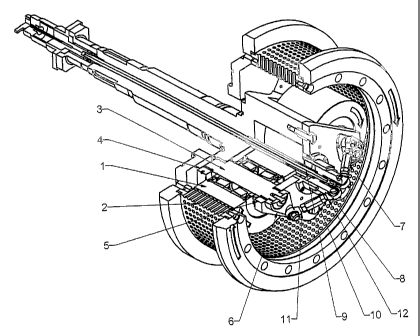Some of the information on this Web page has been provided by external sources. The Government of Canada is not responsible for the accuracy, reliability or currency of the information supplied by external sources. Users wishing to rely upon this information should consult directly with the source of the information. Content provided by external sources is not subject to official languages, privacy and accessibility requirements.
Any discrepancies in the text and image of the Claims and Abstract are due to differing posting times. Text of the Claims and Abstract are posted:
| (12) Patent: | (11) CA 2515751 |
|---|---|
| (54) English Title: | ROLLER ADJUSTMENT APPARATUS FOR AN EXTRUSION MILL |
| (54) French Title: | APPAREIL DE REGLAGE DE ROULEAUX POUR LAMINOIR D'EXTRUSION |
| Status: | Expired |
| (51) International Patent Classification (IPC): |
|
|---|---|
| (72) Inventors : |
|
| (73) Owners : |
|
| (71) Applicants : |
|
| (74) Agent: | ADE & COMPANY INC. |
| (74) Associate agent: | |
| (45) Issued: | 2010-06-15 |
| (86) PCT Filing Date: | 2003-02-21 |
| (87) Open to Public Inspection: | 2004-09-02 |
| Examination requested: | 2007-09-05 |
| Availability of licence: | N/A |
| (25) Language of filing: | English |
| Patent Cooperation Treaty (PCT): | Yes |
|---|---|
| (86) PCT Filing Number: | PCT/DK2003/000115 |
| (87) International Publication Number: | WO2004/073963 |
| (85) National Entry: | 2005-08-12 |
| (30) Application Priority Data: | None |
|---|
In a roller adjustment
apparatus for an extrusion mill,
comprising a cylindrical die (2) with
radially extending extrusion channels
and a number of rollers (1) within
the die, rotatable about their axes and
co-operating with the die to press
material to be treated through the
extrusion channels in the die wall,
the adjustment apparatus comprises
eccentrically journalled bearing
shafts (3) for mounting the rollers
(1), said eccentrically journalling
of the shafts (3) providing a radial
adjustment of the position of the
rollers (1) relative to the die (2),
the rotation of the eccentrically
journalled shafts (3) is provided
by means of extension arms (6)
fixedly mounted on the ends of the
eccentrically journalled shafts (3),
and said extension arms (6) being
connected to an axially movable
connection element (8) by means of
articulated connected linkage rods
(7), and said connection element (8) being connected to a rod (9) provided
with its axis in the axis of the die (2) and extending to a
position outside the material flow of the extrusion mill to move the
connection element (8) in the direction of the axis of the die
(2), said axial movement being provided manually or by means of a suitable
actuator connected to the rod (9). In this way, only
simple mechanical components, such as linkage rods (7) and connection elements
(8) are positioned close to the rollers and these
components are moved by manual adjustment or by means of suitable actuators
positioned outside the aggressive environment
close to the rollers of the extrusion mill.
L'invention concerne un appareil de réglage de rouleaux pour laminoir d'extrusion, qui comprend une matrice cylindrique (2) dotée de canaux d'extrusion s'étendant radialement et un certain nombre de rouleaux (1) contenus dans la matrice, qui peuvent tourner autour de leur axe et coopèrent avec la matrice pour presser la matière destinée à être traitée à travers les canaux d'extrusion ménagés dans la paroi de matrice. L'appareil de réglage comprend des arbres de roulement (3) disposés rotatifs de manière excentrée, destinés au montage des rouleaux (1), ladite disposition rotative des arbres (3) assurant un réglage radial de la position des rouleaux (1) par rapport à la matrice (2). La rotation des arbres (3) disposés rotatifs de manière excentrée est assurée par des bras d'extension (6) montés de manière fixe sur les extrémités des arbres (3) disposés rotatifs de manière excentrée, et lesdits bras d'extension (6) sont reliés à un élément de liaison (8) axialement mobile au moyen de tiges de liaison (7) reliées et articulées. Ledit élément de liaison (8) est relié à une tige (9) dont l'axe se trouve dans l'axe de la matrice (2), et s'étend vers l'extérieur du flux de matière du laminoir d'extrusion, afin que l'élément de liaison (8) soit déplacé dans la direction de l'axe de la matrice (2), ledit mouvement axial étant effectué manuellement ou à l'aide d'un actionneur approprié relié à la tige (9). De cette façon, seuls des éléments mécaniques simples, tels que des tiges de liaison (7) et des éléments de liaison (8), sont placés à proximité des rouleaux, et ces éléments sont déplacés par un réglage manuel ou au moyen d'actionneurs appropriés placés à l'extérieur de l'environnement agressif se trouvant à proximité des rouleaux du laminoir d'extrusion.
Note: Claims are shown in the official language in which they were submitted.
Note: Descriptions are shown in the official language in which they were submitted.

For a clearer understanding of the status of the application/patent presented on this page, the site Disclaimer , as well as the definitions for Patent , Administrative Status , Maintenance Fee and Payment History should be consulted.
| Title | Date |
|---|---|
| Forecasted Issue Date | 2010-06-15 |
| (86) PCT Filing Date | 2003-02-21 |
| (87) PCT Publication Date | 2004-09-02 |
| (85) National Entry | 2005-08-12 |
| Examination Requested | 2007-09-05 |
| (45) Issued | 2010-06-15 |
| Expired | 2023-02-21 |
There is no abandonment history.
Note: Records showing the ownership history in alphabetical order.
| Current Owners on Record |
|---|
| ANDRITZ FEED & BIOFUEL A/S |
| Past Owners on Record |
|---|
| ANDRITZ SPROUT A/S |
| BLOK, JESPER |
| SPROUT-MATADOR A/S |